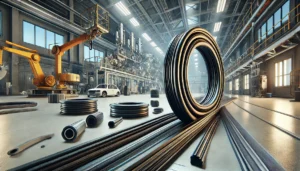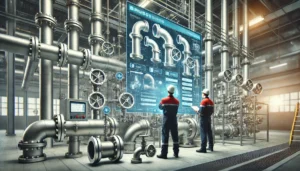Pipe fittings allow the connection and regulation of the flow of liquid in a system, making them a vital part of any piping system. They are designed differently in every shape, size, and material to suit a specific purpose. For every system, selecting the correct pipe fitting requires understanding its types, their materials, and their purpose.
Types of Pipe Fittings
- Elbows: Elbows are the components of a piping system that help change the direction of the flow. These changes in flow pipes come in 90 and 45 degree angles allowing shifts in direction smoothly. Elbows allow space saving while eliminating the need for specific flow directions ─ as such joints are crucial for such systems.
- Tees: Tees are used in systems that require splitting or combining of flow streams as they allow for the branching out of the pipeline. These fittings are created with one inlet and two outlets which help effectively divide the flow into two distinct directions. Just like X shaped water pipes, these are also used extensively in the irrigation of water systems.
- Reducers: Reducers are important for connecting two pipes that have different diameters. Just like their function suggests, they come in eccentric and concentric styles depending on how the pipes are placed. In systems that require constant flow rate, reducers serve their purpose the best in the core systems where equipment have varying inlet and outlet sizes.
- Couplings: These are fittings used to connect two lengths of a pipe at a fixed distance apart without leakage. They come in different sizes and shapes, such as reducing, straight and many more, depending on the piping construction.
- Unions: These are somewhat like couplings, but differ from them in that they allow for quick connection and disconnection of pipes, thus making them ideal for situations that require major servicing or relocation of certain pipe segments.
- Caps and Plugs: Caps seal the top of a pipe, while plugs seal the end of a fitting. Both are important when isolating parts of a pipe installation for repairs or disuse.
- Valves: These are fittings that manage the flow of liquids within any part of a piping network. They can stop, start, regulate, or redirect the flow. They also come in different types, including ball, gate, globe, and check valves.
Materials Used in Pipe Fittings
Choosing the material for pipe fittings should consider the type of liquid, environmental factors, and pressure temperature ranges. Some of the more common are:
- Metals:
- Carbon Steel: A popular choice in many industries due to its high strength, carbon steel is preferred in fittings subject to high pressures.
- Stainless Steel: Its remarkable ability to resist corrosion makes it a great fit for the food and chemical processes.
- Brass and Bronze: These materials provide good corrosion resistance and are often used in plumbing systems.
- Cast Iron: Known for its strength and durability, cast iron is commonly used in low-pressure applications.
- Plastics:
- PVC (Polyvinyl Chloride): The most common use for PVC piping comes in water and drainage systems due to its light weightedness and corrosion resistance.
- CPVC (Chlorinated Polyvinyl Chloride): With the same use as PVC but is better suited for hot water systems.
- HDPE (High-Density Polyethylene): Most commonly used for gas and water distribution systems because of its strength and flexibility.
- PP (Polypropylene): Has a good resistance towards various chemicals, hence it is used in a number of industries.
- Others:
- Rubber: Used in the making of flexible connectors to reduce the negative effects of movement in various parts of machines and buildings.
- Composite Materials: These fittings are composed of fiberglass and resin making them durable and corrosion resistant.
Applications of Pipe Fittings
- Water and Wastewater Systems: The fittings serve a most common use in the water and sewage infrastructures where they allow to treat and distribute water.
- Oil and Gas Industry: In this field, pipe fittings are needed for transferring crude oil, gas, and refined products because of the requirement for high pressure and corrosive material.
- Chemical Processing: During the construction of chemical processing plants, pipe fittings used to manage activities and processes associated with the various chemicals used are designed and built from highly reactive compounds. Such compounds must possess tolerance against a chemical reaction to extremely high temperatures.
- HVAC Features: The distribution of the air and fluids through piping systems in Heating, Ventilation, and Air Conditioning (HVAC) systems relies on pipe fittings. Therefore, the fittings must be capable of withstanding changes in temperature and pressure.
- Food and Beverages Sector: Transportation of liquids and gases in the industry is done through the use of pipe fittings but certain materials must Pass the hygienic standards and tolerably pass the cleaning stages.
Conclusion
It is vital knowing the pipe fittings types, the materials, and their considerations to the system need to be familiarized with to ensure safer and more efficient piping systems are designed and maintained. In selecting the right fitting for the specific needs of the system, the right performance and the deserved life expectancy are achieved. The ongoing developments in science and technology of materials are broadening the range of possibilities for more efficient piping and tools in many fields.










